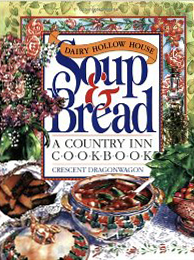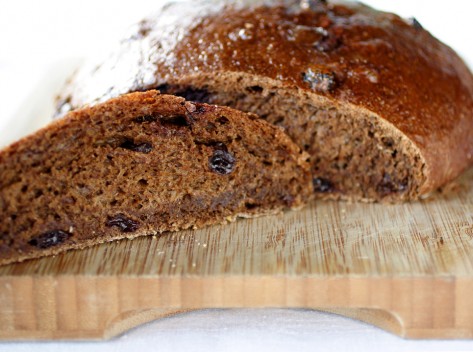Soup, Bread & Salad: Good Eating Year-round On Offer From a Generous Author
 DAIRY HOLLOW HOUSE SOUP & BREAD
DAIRY HOLLOW HOUSE SOUP & BREAD
A Country Inn Cookbook
By Crescent Dragonwagon
Workman Publishing
406 pp. (out of print)
I don’t know Crescent Dragonwagon personally, but after reading her Dairy Hollow House Soup & Bread cookbook from start to finish, and making several successful recipes from it, I feel as if I’ve gotten to know something of her—enough to bet that generosity is one of her best-loved traits. In our author-reader/cook-to-cook relationship, I feel doted on. All of my questions about technique have been anticipated, my curiosity about an ingredient or genesis of a recipe satisfied, my experience of the foods enriched by Crescent Dragonwagon’s high-quality prose and selection of quotes from poets, cooks, and artists, and, most importantly, the recipes deliver on her promises.
At the Dowdy Corners Cookbook Club potluck, we enjoyed cornbread, gumbo, Creamy Garlic Soup with White Wine, and Avocado and Orange Salad with Orange-Scallion Vinaigrette. There were no bombs at the potluck table or in our own kitchens. We all commented on how much we enjoyed the recipes we tried from the book. Besides these potluck dishes, other standouts include: New World Corn Chowder, Chicken and Cheese Soup with Green Chilies, Mulligatawny, the Sherried Sesame Vinaigrette (intended for a composed salad of asparagus and snow peas, but it’s so delicious that I used it with just about any salad combination), Colcannon Soup (a traditional Irish combo of braising greens, dairy, and potatoes), Cuban Black Bean Soup, Broccoli and Potato Curry Soup Primo, Chilled Strawberry Soup with Crème Fraîche, Chilled Avocado Soup Mexique Bay, Cream of Leek, Herb, and Garden Lettuce Soup, Raisin-Pumpernickel Bread with a Secret (there are actually two secrets: chocolate chips and instant coffee). One club member said she was particularly impressed with the cream and dairy-based soups (there an entire chapter devoted to them). She tried several and found them all to be quite good.

Raisin-Pumpernickel Bread with a Secret
Dairy Hollow House Soup & Bread is the first out-of-print book DCCC has chosen. It proves two things: 1) There are many good out-of-print books worth revisiting; 2) Just because an ingredient or food is no longer the “it” thing in culinary circles, doesn’t mean it’s not good and worth revisiting. Case in point: In this book, published in 1992, there are memory lane recipes for raspberry vinaigrette (other uses for raspberry vinegar are included as well), for pumpernickel bread with chocolate and dried fruit (I recall this bread with dried cherries; here raisins are used), and for the “Soup,” a low-fat soup vegetable soup that reminds me of the “cabbage soup diet,” popularized in the eighties and nineties, though Crescent Dragonwagon’s looks tastier, and she doesn’t stipulate what you can or cannot eat in addition to the soup. She simply presents “The Soup” as a wholesome, nutritious, and low-fat meal. I was tempted to try it as an experiment—after several months of throwing myself into the club and blog–related activities of cooking, eating, and writing (not a good combination, the latter being a completely sedentary activity), I’d gained a few pounds. But I couldn’t bring myself to do it. There are just too many, much more enticing recipes in the book. The only oddity in the book, to my mind, is the use of Pam cooking spray in several of the soup and some of the bread recipes. I simply omitted it, or substituted it with a neutral fat, if it seemed necessary.
Because Crescent Dragonwagon’s recipes are so thorough, and detailed, they can be followed with success by less practiced cooks, unless a long list of ingredients is off-putting; for the very same reason, cooks with some time behind them in the kitchen will also benefit from them. Somewhere within the 400+ pages of this book, you will learn a new approach, angle, treatment, or even word. Instead of calling that pistou, garlic oil, or dab of crème fraîche a garnish, implying something purely decorative, why not call it a “fillip,” an embellishment that’s intended to arouse or excite, as Crescent does.
You will learn useful how’s and why’s, including tips for making soups with delicate ingredients, such as fish—the trick here is to add lightly poached fish directly to individual soup bowls to avoid over cooking; how to slice fresh fennel properly; how many pounds of fresh pumpkin will render just the amount cups of pureed pumpkin needed; why it’s better to cook dried beans in the same liquid they’ve been soaked in (Crescent has just come out with a cookbook devoted entirely to beans, so I’ll take her advice on the subject); how to prepare fresh mussels, should you find yourself living inland but in an area rich with streams and rivers; how to properly thicken with cornstarch (here Crescent warns against overbeating cornstarch when incorporating a slurry into a hot liquid as overbeating will break down the thickening).
Because I consider myself a salad aficionado, the most interesting discovery to me is her method for making a basic green salad, which she calls “The Salad.” To begin, her favorite lettuce drying technique, superior to using a salad spinner, she says, was news to me: The method is to put the thoroughly cleaned greens in a clean pillow case, preferably flannel, and whirl it around and around above your head.
To make “The Salad,” she puts olive oil and garlic paste (she puts the garlic through a garlic press) in a bowl. She then adds the lettuces and gently tosses the greens in the oil until each leaf glistens with oil. Then she sprinkles on the acid (she uses fresh lemon juice). She feels the oil coating helps to seal in moisture and flavor, and helps keep the greens crisp, longer, if only for brief window of time. (I tried this and do think the intrinsic flavor of the greens shone through more clearly when tossed with oil first, but the difference is subtle.)
There are no photos to enliven the pages of this book, but there are charming illustrations sprinkled throughout, the above-mentioned quotes, and Crescent’s own prose, which evokes the place, foods, and people she writes about. Take the following, for example, perhaps the most “adult” passage in the book, where she writes about the ideal tomato:
The kind you don’t even get at a farmer’s market, but only out of your own garden. The kind you find only after you’ve parted that private, aromatic foliage, and reached up through the rusting hairy leaves. The kind of tomato there’s only one of, and that one—just on the point of falling—is lush in your palm and still hot from the sun.

Holly, I’m friended with Crescent on Facebook. Her posts are like reading a memoir, an autobiography, a heartfelt and fiery journal. Heretofore I had thought I was the pornest of the tomato describers, but I do believe Crescent surpasses me.
1Sharon, I just saw your name on Crescent’s facebook page today, so what a coincidence. To say the least, her tomato passage in the soup book jumped out at me. I bet Crescent would enjoy knowing you approve of her x-rated text, coming from you, a true queen of tomatoes.
2What a pity that this is out of print! A roommate gave it to me the year after I graduated from college, and it was the first cookbook I ever tried to cook out of. Although I came to rely on it mostly for the bread recipes, I started with “The Soup,” and found it much tastier than I had expected! Incidentally, I love it that there is a thing called “Dowdy Corner Cookbook Club.”
3Well, maybe if enough people clamor for it, a publisher will reprint it. Sometimes that happens. What a great book for a graduation present. There are enough recipes and interesting info to keep any cook going for quite some time. Glad you like the club’s name. It’s the name of a real place, so I can’t say I was original enough to think it up myself.
4